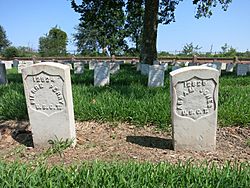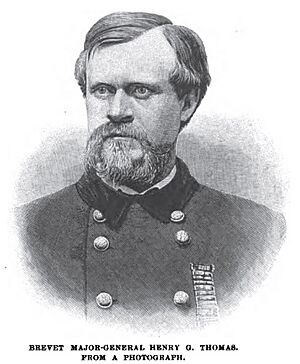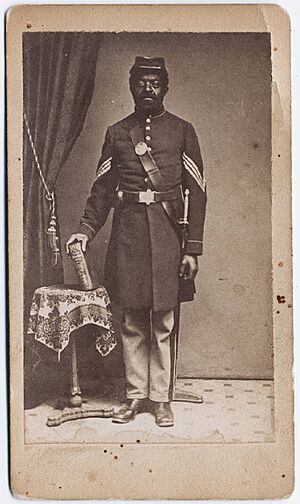29th United States Colored Infantry Regiment facts for kids
Quick facts for kids 29th United States Colored Infantry Regiment |
|
|---|---|

Graves of U.S. Colored Troops at Chalmette National Cemetery in New Orleans
|
|
| Active | 24 April 1864 – 6 November 1865 |
| Country | |
| Allegiance | |
| Branch | Union Army |
| Type | Infantry |
| Size | Regiment |
| Engagements |
|
| Commanders | |
| Notable commanders |
John A. Bross Clark E. Royce |
The 29th United States Colored Infantry was a special army unit during the American Civil War. It was made up of African Americans from Illinois. This unit was part of the Union Army, which fought to keep the United States together.
The regiment officially started in April 1864. They were sent to the Eastern Theater, which was the main fighting area in Virginia. This unit was part of a division where all the soldiers were African American. They helped guard army supplies and dig trenches.
Their first big battle was the Battle of the Crater in July 1864. They faced heavy losses there. The 29th USCI also fought in other battles during the Siege of Petersburg. They were part of the final Appomattox Campaign in April 1865. After the war, the unit moved to Texas. They were likely in Galveston when General Gordon Granger announced that all enslaved people were free. This happened on Juneteenth (June 19, 1865). The regiment finished its service in November 1865.
Contents
Forming the Regiment
After President Abraham Lincoln issued the Emancipation Proclamation in January 1863, he asked for African American soldiers to join the Union Army. Eventually, about 300,000 African American soldiers served in 166 special regiments. These units were called colored regiments.
Most of these regiments were infantry, meaning foot soldiers. About 60 of them fought in actual battles. White officers led these regiments, while all the regular soldiers were African American. At first, it was hard to get enough black recruits. This was because they were paid less than white soldiers. Also, there were worries that Confederate soldiers would treat captured black soldiers very badly.
The War Department created a special office called the Bureau for Colored Troops. This office decided which white soldiers would become officers in the new colored regiments. Many white officers wanted these jobs because they could get promoted quickly.
The 29th United States Colored Infantry Regiment (29th USCI) was formed in Quincy, Illinois. It officially joined the army on April 24, 1864. Lieutenant Colonel John A. Bross from Chicago helped organize the regiment. He became its first commanding officer. Bross had fought in earlier battles, like the Battle of Stones River.
The regiment had ten companies, from A to K. Most of the soldiers came from Illinois and Missouri. For example, Company A was mostly from Quincy, and Companies B, C, and D were largely from Chicago. One soldier, William H. Costley, joined Company B. His mother, Nance Legins-Costley, had been freed from slavery by the Illinois Supreme Court in 1841. Abraham Lincoln himself had represented her in that court case.
Service in the War
The Battle of the Crater
The 29th USCI first went to Annapolis, Maryland, then to Alexandria, Virginia. They helped defend Washington, D.C.. In June 1864, the regiment moved to Virginia and joined the IX Corps. This army group was known for being fair to all races.
The 4th Division of the IX Corps was made up entirely of black soldiers. Their commander was Brigadier General Edward Ferrero. For a few weeks, the 4th Division guarded army supply wagons. The main army commander, Major General George Meade, thought black soldiers were better for labor than for fighting. But by July, the 4th Division rejoined the IX Corps.
At this time, the Siege of Petersburg was stuck in a stalemate. A Union officer, Lieutenant Colonel Henry Pleasants, had a bold idea. He suggested digging a tunnel under the Confederate trenches. Then, they would use explosives to blow a hole in the enemy's defenses. Lieutenant General Ulysses S. Grant agreed to the plan.
The IX Corps was chosen to lead the attack. Its white divisions were tired from fighting. But the 4th Division, with its black soldiers, was eager to fight. So, the IX Corps commander, Major General Ambrose Burnside, chose the 4th Division to lead the charge. Their plan was to go around the giant hole created by the explosion. Then, they would capture a key ridge farther ahead.
However, Major General Meade did not want black troops to lead the attack. He worried that if they were killed, people would think the Union Army didn't care about them. Grant agreed with Meade. So, just 12 hours before the attack, Grant ordered Burnside to pick a white division instead.
The Battle of the Crater began at 4:45 AM on July 30, 1864. The mine exploded, creating a huge hole 200 feet long, 50 feet wide, and 25 feet deep. But the white soldiers chosen to lead the attack hesitated. Many of them simply jumped into the crater for cover instead of moving forward. Their commander, Brigadier General James H. Ledlie, stayed far behind the lines.
Finally, at 7:30 AM, the 4th Division, including the 29th USCI, was ordered to advance. They ran forward quickly. Seeing the crater was full of soldiers, the 29th USCI moved to the right into a captured trench. As they tried to rush the ridge, they were hit by heavy enemy fire.
Lieutenant Colonel Bross, the commander of the 29th USCI, led his men into battle. He was carrying the regiment's flag when he was shot and killed. Another officer who picked up the flag was also shot down. The Confederates then launched a strong counterattack. They overwhelmed the Union troops in the crater. The 4th Division suffered about 1,300 casualties in this terrible battle.
The 29th USCI lost many men at the Battle of the Crater. Two officers and 38 soldiers were killed. Four officers and 53 soldiers were wounded. Another 33 soldiers were captured. Lieutenant Colonel Bross died on July 30. Captain William H. Flint also died that day, and Captain Hector H. Aiken died from his wounds a few days later.
Later Actions
The 29th USCI was also present at the Battle of Globe Tavern in August 1864. They fought in other battles near Petersburg, like the Battle of Peebles's Farm in September and the Battle of Boydton Plank Road in October.
In December 1864, the 29th USCI joined the XXV Corps. This was a new army group made up entirely of African American troops. On January 1, 1865, Clark E. Royce became the new colonel of the 29th USCI.
In spring 1865, the regiment held trenches in Virginia. On April 2, 1865, they took part in a major attack that broke through the Confederate defenses. The 29th USCI marched into Petersburg singing John Brown's Body. They continued to fight in the Appomattox Campaign until April 9, 1865, when the war ended.
After the war, the 29th USCI stayed in Virginia for a short time. Then, in May 1865, they were ordered to Texas. They sailed to Mobile, Alabama first, then continued to Texas. The journey was rough due to storms. Some records say the regiment landed in Galveston between June 18 and 20, 1865. This meant they were there when General Granger announced that all enslaved people in Texas were free. This important event is now celebrated every year as Juneteenth.
The 29th USCI stayed in Texas, guarding the Rio Grande river, until they officially left the army on November 6, 1865. During its service, the 29th USCI had 2,072 soldiers. About 46 soldiers were killed in battle or died from their wounds. Another 188 soldiers died from diseases.
Images for kids
-
Graves of U.S. Colored Troops at Chalmette National Cemetery in New Orleans








